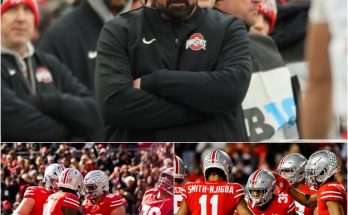LSU head coach Brian Kelly has confirmed that cornerback Ashton Stamps is no longer part of the team. The announcement, while concise, carries a weight that extends beyond a simple roster adjustment. For LSU fans and college football followers alike, the news marks another chapter in the ever-evolving landscape of college athletics—where young athletes navigate decisions about playing time, development, and the pursuit of opportunities elsewhere. Stamps, who plans to redshirt this season before entering the transfer portal, leaves LSU with mixed emotions surrounding his brief tenure in Baton Rouge. His departure highlights the complex realities of modern college football: competition, adaptability, and the constant quest for fit between player and program.
Ashton Stamps, a native of Louisiana, entered LSU with promise and local pride. A product of Archbishop Rummel High School, Stamps was seen as a talented defensive back with the kind of speed, awareness, and physicality that fits perfectly into LSU’s long tradition of elite secondary play. Known as “DBU” for its legacy of producing NFL-caliber defensive backs—like Tyrann Mathieu, Patrick Peterson, and Derek Stingley Jr.—LSU has always placed immense expectations on its cornerbacks. For a hometown recruit like Stamps, joining the Tigers wasn’t just about football; it was about representing his community, his state, and the program he grew up admiring.
However, as often happens in college sports, the path from potential to playing time isn’t always straightforward. Stamps found himself competing for snaps in one of the most competitive defensive back rooms in the country. With transfers, new recruits, and position shifts constantly shaping LSU’s depth chart, young players like Stamps often face difficult decisions about their future. When Brian Kelly confirmed that Stamps would redshirt and later enter the transfer portal, it reflected a mutual understanding that the best move for both the player and the program might be a new beginning elsewhere.
Kelly’s tone during the confirmation was calm and professional, signaling respect for Stamps’ decision. “We wish Ashton the best moving forward,” Kelly reportedly said. “He’s a good young man, and sometimes a fresh start is what’s needed for growth.” Those words capture the essence of today’s college football environment. The NCAA transfer portal has changed the dynamics between players and programs, offering athletes more control over their destinies while simultaneously forcing coaches to constantly manage roster turnover.
For Stamps, the decision to redshirt this season suggests a thoughtful approach to his next move. By preserving his eligibility, he positions himself to transfer with multiple years of playing time remaining—an attractive situation for both him and prospective programs. It also gives him the chance to develop physically and mentally without losing valuable eligibility, which could make a significant difference in the next phase of his career.
The transfer portal, while controversial to some, has become a defining feature of the modern college game. What was once viewed as a last resort for players dissatisfied with their roles has evolved into a strategic tool for career advancement. In Ashton Stamps’ case, it may offer a path to more consistent playing time and a system that better aligns with his skill set. LSU, meanwhile, will continue to adjust its roster, as Kelly and his staff focus on both recruiting and retention in an increasingly fluid landscape.
For LSU fans, news of player departures is never easy, particularly when it involves young athletes with potential. However, these moments also underscore how competitive the program has become under Brian Kelly’s leadership. Since his arrival from Notre Dame, Kelly has made it clear that roster management at LSU would be guided by high standards and accountability. The Tigers’ goal remains to compete for championships, and that requires both depth and cohesion. Sometimes, that means talented players seek opportunities elsewhere to maximize their individual potential.
In the grand picture, Stamps’ story is far from over. His time at LSU—though brief—has given him exposure to elite coaching, SEC-level competition, and the discipline required to thrive at the highest level of college football. Those experiences often become valuable lessons for players who transfer to other programs. Many former LSU players have left Baton Rouge only to excel at new schools, using their time with the Tigers as a foundation for success.
Moreover, this kind of decision often requires significant maturity. For a young athlete, recognizing that the current situation isn’t the best fit and choosing to seek a better one demonstrates both self-awareness and courage. It’s a decision not made out of frustration alone, but out of a desire to fulfill one’s potential. Redshirting this season will allow Stamps to focus on his development—physically, technically, and mentally—so that when he steps onto the field again, he can do so as a more complete player.
From LSU’s perspective, roster movement is now part of the rhythm of college football seasons. Every year, players enter and exit, and coaches must continuously re-evaluate their depth charts. Kelly and his staff have been particularly aggressive in using both the transfer portal and traditional recruiting to rebuild LSU’s defense. They’ve emphasized versatility and adaptability, qualities essential in the SEC, where high-powered offenses dominate. The competition for defensive back roles has been intense, with both returning veterans and incoming transfers battling for snaps. In such an environment, even talented players like Stamps can find themselves on the outside looking in.
For fans, it’s worth remembering that the college experience is about more than just football. Young men like Ashton Stamps are balancing academics, athletic commitments, and personal development—all under the scrutiny of fans and media. The pressure to perform, especially in a football-crazed state like Louisiana, can be immense. When a player decides to step away or transfer, it’s rarely an easy choice. It involves discussions with family, coaches, and mentors, and it reflects a careful weighing of priorities and goals.
Looking ahead, there’s reason to believe that Stamps can flourish in his next chapter. His natural athleticism and instincts as a cornerback remain his core strengths. He’s quick on his feet, reads quarterbacks well, and has shown flashes of strong tackling and coverage ability. Those skills will attract attention from programs across the country, especially those in need of young defensive backs who can grow into starting roles. With the right coaching environment and scheme, Stamps could develop into a reliable contributor and perhaps even an NFL prospect down the line.
In the broader conversation, this situation also points to the changing expectations of college athletes. Today’s players are more empowered than ever before to make decisions that serve their individual futures. Between the transfer portal and Name, Image, and Likeness (NIL) opportunities, athletes are approaching college football with a professional mindset. They understand that their college years are both a developmental phase and a business decision. For some, that means finding a place where their talents can shine brightest—even if it means leaving a program as prestigious as LSU.
Brian Kelly, for his part, has consistently emphasized transparency and communication within his program. When players decide to move on, he handles those transitions with professionalism, acknowledging the realities of the modern game. His approach helps maintain the team’s focus and morale, ensuring that departures don’t become distractions. LSU’s defensive room remains deep and competitive, and while Stamps’ departure creates a small void, it also opens opportunities for other young players to step up.
Ultimately, the story of Ashton Stamps and LSU is one that reflects the balance between individual ambition and team dynamics. It’s about understanding when to stay and when to move forward. It’s about acknowledging that success in college football isn’t just defined by where you start, but by how you adapt to challenges and pursue growth. Stamps’ choice to redshirt and transfer may one day be seen as the pivotal decision that reignited his career.
In time, LSU fans will likely look back on this moment not with disappointment, but with understanding. After all, college football is a journey for everyone involved—the players, the coaches, and the supporters who invest their emotions in each game. For Stamps, the next step in that journey begins now, and wherever he lands, he’ll carry with him the lessons, pride, and toughness that come from wearing the purple and gold.
As the Tigers continue their season, Brian Kelly’s message remains clear: LSU’s standard is excellence, but excellence comes with evolution. Players will come and go, but the program’s identity endures. And for Ashton Stamps, the story doesn’t end here—it merely turns a page, opening the door to new opportunities, new challenges, and perhaps, a new chapter of success waiting to be written.
In a sport built on competition, change, and resilience, both sides move forward with respect. LSU continues its pursuit of championships, while Ashton Stamps continues his pursuit of growth. That’s the essence of college football—a constant cycle of development, transition, and hope for what lies ahead.



